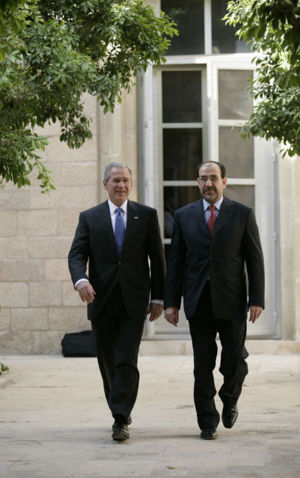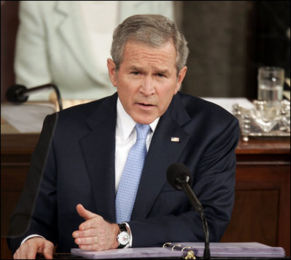George W. Bush
George W. Bush became the 43rd president of the United States in January of 2001. His popularity soared in the aftermath of the 9-11 Attack, and operations in Iraq and the invasions of Afghanistan; he and his Vice President Dick Cheney won reelection in 2004. However, due to the prolonged conflict in Iraq and numerous scandals in the administration, he lost public support and in 2006 the Democratic Party won a majority in both houses of the Congress.
He was elected as a Republican over Democrat Al Gore in a controversial election in 2000. In that election, although he lost the overall national popular vote, he won the Electoral College election, due to a 500-vote lead in Florida. His victory in Florida was corroborated by the 5-4 Supreme Court decision Bush v. Gore which ended Gore's efforts to recount the vote again. Bush was re-elected over Senator John Kerry in 2004 by a three million vote margin. Prior to his presidency he was governor of Texas (1994-2001), and served as an aide to his father, President George H. W. Bush.
Important markers during his administration included the 9-11 terrorist attack, the invasions of Afghanistan and Iraq, the expansion of NATO to the Russian border, the midterm election gains of 2002, the midterm loss of Congress in the 2006 elections, improved relations with India, the passage of the PATRIOT Act, the No Child Left Behind education act, repeated large-scale tax cuts, the economic recovery, the boom (and later correction) in real estate, the debate on illegal immigration, the handling of the 2005 Hurricane Katrina disaster, the U.S. Attorneys dismissal controversy, and the appointments of conservatives to the Supreme Court and Federal Reserve chairmanship. Intense controversy in 2007 focused on the war in Iraq. Bush will be ineligible for the presidential election in 2008 due to a two-term limit in the United States Constitution.
September 11th and the War on Terror
On September 11, 2001, a team of 19 hijackers launched suicide attacks that destroyed the World Trade Center in New York and damaged the Pentagon, causing 3000 deaths in the worst terrorist attack in American history. The militant Islamist Osama bin Laden, presumed founder of the al-Qaeda terrorist organization, claimed responsibility for the attacks. Bush responded by instituting a U.S.-led "war on terror" to combat terrorism. He ordered the invasion of Afghanistan to overthrow the Taliban government, which had given asylum to bin Laden. However, bin Laden himself was never found. The ramifications of the September 11th also included the invasion of Iraq, overthrowing the dictatorial regime of Saddam Hussein, along with the country's subsequent slide into civil conflict; and the passage of the Patriot Act, to facilitate the detection of terrorist activities.
War in Iraq

The war in Iraq was the defining event of Bush's second term; as the war became increasingly unpopular his own ratings fell, and his influence weakened. Bush stated three goals in launching the invasion: overthrowing the cruel and dangerous regime of Saddam Hussein, establishing a model democracy in Iraq, and leaving after stability was assured. There was no question about Saddam's horrors within Iraq, but his dangers to the U.S. appeared exaggerated when no weapons of mass destruction were discovered. By 2005, the Iraqis formed a government, enacted a constitution and held elections. Even after these mile markers, parts of the nation were wracked by a violent insurgency as Sunnis fought Shiites with tens of thousands killed. Over 2000 American soldiers were killed by ambush by mid 2007. By late 2006, many Democratic leaders demanded a fixed timetable. A compromise was reached in summer 2007 whereby a major report would be issued by mid-September evaluating how well the Iraqis had achieved the goals set by the White House.
Courts and Justice
Bush nudged the U.S. Supreme Court to the right with his successful nominations of John Roberts as Chief Justice and Samuel Alito as Associate Justice of the Supreme Court in 2005. Liberal opponents denounced the these nominees as too conservative, but both were speedily confirmed. His nomination of three judges to the federal circuit courts was threatened with filibuster from Senatorial Democrats, but a bipartisan coalition (calling itself the "Gang of 14") reached a bipartisan compromise and these judges were likewise confirmed. In 2007, some alleged that Attorney General Alberto Gonzalez removed of some district attorneys for political reasons, and as a result some politicians demanded but did not get the resignation of Alberto Gonzalez. [1] Fierce debates, some reaching the Supreme Court, raged over the proper legal status of prisoners from the Mideast conflict held in CIA prisons and the prison the U.S. operated at Guantanamo (in Cuba).
Social policy
Bush put his prestige on the line in collaborating with Democrats for a major reform of the immigration system, which would have opened a path to citizenship for 12 million illegal immigrants (most of them from Central America and Mexico). Polling showed that many Americans think that US immigration policies and laws need to be reformed and some business community and religious groups supported President Bush's proposed legislation. [2][3] But ultimately, the measure proved largely unpopular with US citizens. [4][5] It was defeated when 2/3 of Republican Senators voted it down in June 2007.
During his presidency, many believe Bush has leaned conservative in terms of social policy, but many conservatives are disappointed in the fact that Bush has managed an explosive growth in government. Bush's budgets have led to the highest spending levels in almost every social program in American history. He opposed same-sex marriage and supported a constitutional amendment to federally ban it, but the amendment was not formally proposed in Congress. He advocated for the Partial-birth Abortion Ban Act which prohibits a specific form of late-term abortion. The Act, which Clinton had vetoed, was passed by 2:1 majorities in Congress, signed by Bush, and was upheld in the Supreme Court in the case Gonzales v. Carhart.
Bibliography
- Academic
- Abramson, Paul R., John H. Aldrich, and David W. Rohde. Change and Continuity in the 2004 and 2006 Elections (2007), 324pp
- Berggren, D. Jason, and Nicol C. Rae. "Jimmy Carter and George W. Bush: Faith, Foreign Policy, and an Evangelical Presidential Style." Presidential Studies Quarterly. 36#4 2006. pp 606+. online edition
- Campbell, Colin, and Bert A. Rockman, eds. The George W. Bush Presidency: Appraisals and Prospects. Congressional Quarterly Press, 2004.
- Campbell, Colin, Bert A. Rockman, and Andrew Rudalevige, eds.. The George W. Bush Legacy Congressional Quarterly Press, 2007. 14 essays by scholars
- Congressional Quarterly. CQ Almanac Plus highly detailed annual compilation of events in Congress, White House, Supreme Court, summarizing the weekly "Congressional Quarterly Weekly Report". (annual, 2002-2007)
- Corrado, Anthony, E. J. Dionne Jr., Kathleen A. Frankovic. The Election of 2000: Reports and Interpretations (2001) online edition
- Edwards III, George C. and Philip John Davies, eds. New Challenges for the American Presidency New York: Pearson Longman, 2004. 245 pp. articles from Presidential Studies Quarterly
- Greenstein, Fred I. ed. The George W. Bush Presidency: An Early Assessment Johns Hopkins University Press, 2003
- Greenstein, Fred I. “The Contemporary Presidency: The Changing Leadership of George W. Bush A Pre- and Post-9/11 Comparison” in Presidential Studies Quarterly v 32#2 2002 pp 387+. online edition
- Gregg II, Gary L. and Mark J. Rozell, eds. Considering the Bush Presidency Oxford University Press, 2004. 210 pp. British perspectives
- Hendrickson, Ryan C., and Kristina Spohr Readman, "From the Baltic to the Black Sea: Bush's NATO Enlargement." White House Studies. (2004) 4#3 pp: 319+. online edition
- Hilliard, Bryan, Tom Lansford, and Robert P Watson, eds. George W. Bush: Evaluating the President at Midterm SUNY Press 2004
- Jacobson, Gary C. “The Bush Presidency and the American Electorate” Presidential Studies Quarterly v 33 #4 2003 pp 701+. online edition
- Moens, Alexander The Foreign Policy of George W. Bush: Values, Strategy, and Loyalty. Ashgate, 2004. 227 pp.
- Sabato, Larry J. ed. The Sixth Year Itch: The Rise and Fall of the George W. Bush Presidency (2007), experts on the 2006 elections in major states
- Pro-Bush
- Barnes, Fred. Rebel-in-Chief: How George W. Bush Is Redefining the Conservative Movement and Transforming America (2006)
- Robert Draper. Inside the Bush White House: The Presidency of George W. Bush (2007), authorized biography
- Karen Hughes. George W. Bush: Portrait of a Leader, (2005)
- Bob Woodward. Plan of Attack (2003) on Iraq war
- Anti-Bush
- Bruce Bartlett, Impostor: How George W. Bush Bankrupted America and Betrayed the Reagan Legacy (2006), conservative attack by former aide
- James Moore and Wayne Slater. Bush's Brain: How Karl Rove Made George W. Bush Presidential. 2003. online edition
- Ron Suskind. The Price of Loyalty: George W. Bush, the White House, and the Education of Paul O’Neill (2004), complaints of ex Treasury Secretary
- Primary sources
- George W. Bush. George W. Bush on God and Country: The President Speaks Out About Faith, Principle, and Patriotism (2004)
See also
- ↑ Seven senior Justice department officials did resign.
- ↑ http://www.fairus.org/site/PageServer?pagename=research_researchd74c
- ↑ http://www.washingtonpost.com/wp-dyn/content/graphic/2007/06/04/GR2007060400089.html
- ↑ http://www.rasmussenreports.com/public_content/politics/just_22_favor_stalled_immigration_bill
- ↑ http://www.rasmussenreports.com/public_content/politics/immigration_bill_failure_proves_rasmussen_s_first_law_of_politics

